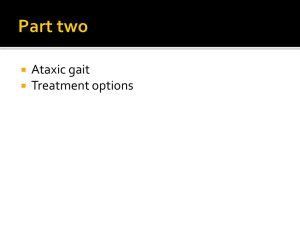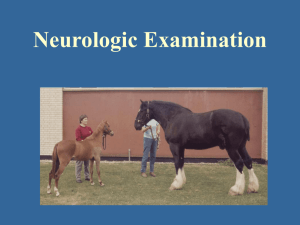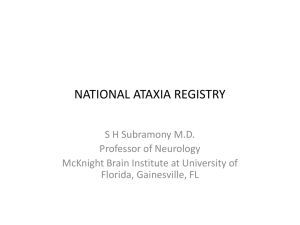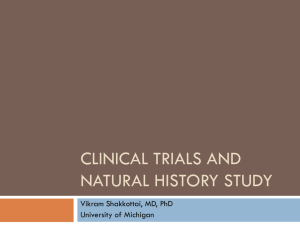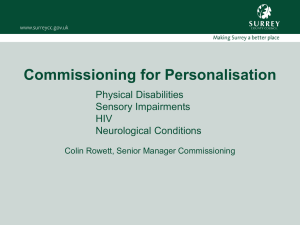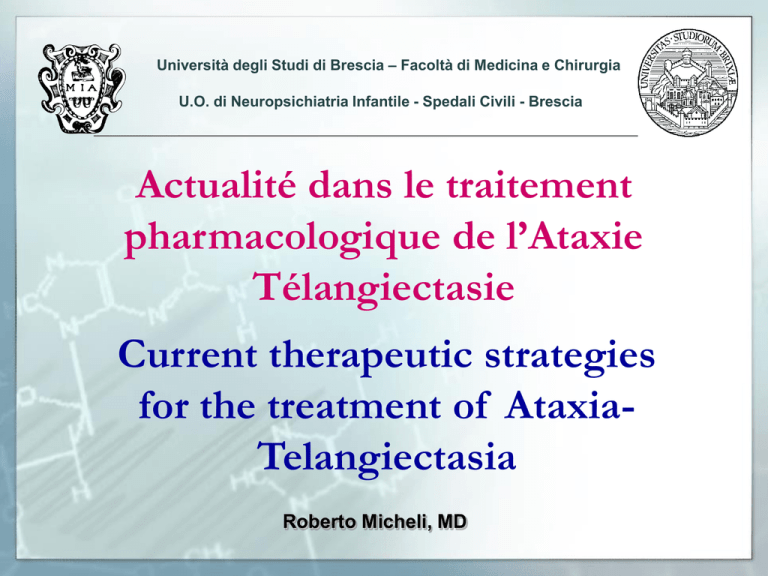
Università degli Studi di Brescia – Facoltà di Medicina e Chirurgia
U.O. di Neuropsichiatria Infantile - Spedali Civili - Brescia
Actualité dans le traitement
pharmacologique de l’Ataxie
Télangiectasie
Current therapeutic strategies
for the treatment of AtaxiaTelangiectasia
Roberto Micheli, MD
ATAXIA-TELANGIECTASIA
Definition: rare autosomal recessive multisystemic disorder.
Incidence: 1: 300.000 – 1: 40.000 in newborns.
Etiology: biallelic mutations in the ATM gene (Chr 11q22-23), that encodes a
protein kinase which plays a pivotal role in DNA repair, targeting hundreds of substrates
involved in cell cycle checkpoints.
Pathogenesis: DNA-repair defect syndromes.
• In neuronal cells, unrepaired DNA tend to accumulate and eventually cause the death of
Purkinje cells.
• Oxidative processes, induced by release of oxygen radicals from the mitochondria, is a
major contributor to neurodegeneration.
• Patients with ataxia telangiectasia are especially prone to oxidative stress, because the ATM
protein by itself is a scavenger of reactive oxygen species.
ATAXIA-TELANGIECTASIA :
CLINICAL MANIFESTATIONS
ATAXIA TELANGIECTASIA:
DIAGNOSIS
High serum alpha-fetoprotein level (95% pt.).
Chromosomal instability (chromosome breakage, inversions and
translocations > chromosomes 7 and 14).
Increase in spontaneous and radiation-induced chromosomal
breaks.
Reduced/absent IgA levels (70%) and ATM protein (98%)
Proven molecular diagnosis of A-T based on ATM gene mutations
and/or ATM protein deficiency (Western Blot).
ATAXIA-TELANGIECTASIA:
PROGNOSIS
Progressive neurodegeneration.
Dramatically affect the quality of life: wheelchair dependency
toward the second decade of life.
Prognosis is poor: life expectancy is around 25 years, with a
wide range. Pulmonary infections and cancer are the two most
common causes of death in patients with A-T.
ATAXIA-TELANGIECTASIA :
NEUROLOGICAL DYSFUNCTION
Cerebellar ataxia (100% pt.)
• Generally the presenting symptom; progressive.
• Narrow gait ataxia.
• Neck posturing (anterior or posterior bending).
Extrapyramidal involvement (70% pt.)
• Disabling, in some cases prevalent manifestations.
• Hyperkinetic movement disorders / Parkinsonian features.
Eye movement abnormalities (80% pt.)
• Oculomotor apraxia.
• Significant morbidity, including reading impairment.
SM axonal peripheral neuropathy
Cognitive profile
ATAXIA-TELANGIECTASIA:
TREATMENT
No established therapy is currently available
Treatments are symptomatic and supportive only
Therapy and prophylaxis of infections:
Early antibiotic treatment and continuous prophylactic therapy
Vaccines (S. pneumoniae; N. meningitidis; H. Influenzae);
Regular injection of immunoglobulins.
;
Rehabilitation and supportive care:
Physical,
occupational and speech/swallowing neurorehabilitation.
Adaptive equipment, including braces, walkers, orthotics, wheelchairs and computers
X-ray exposure should be limited to times when it is medically necessary!
POTENTIAL THERAPEUTIC STRATEGIES
Use of antioxidants
Mutation-targeted therapies:
Correction of ATM gene function by read-through of premature termination
codons (aminoglycosides)
Correction of ATM splicing mutations with antisense morpholino
oligonucleotides
POTENTIAL THERAPEUTIC STRATEGIES
Oral Betamethasone
POTENTIAL THERAPEUTIC STRATEGIES
Oral Betamethasone
A Randomized Trial of Oral Betamethasone to Reduce
Ataxia Symptoms in Ataxia Telangiectasia
Zannolli et al., 2012
A Randomized Trial of Oral Betamethasone to Reduce
Ataxia Symptoms in Ataxia Telangiectasia
Zannolli et al., 2012
Study design summarizing the double-blind crossover trial of BETA
versus placebo
A Randomized Trial of Oral Betamethasone to Reduce
Ataxia Symptoms in Ataxia Telangiectasia
Zannolli et al., 2012
Association between the change in ICARS total score and plasma level of
BETA in the ITT population.
Higher BETA plasma levels
corresponded with greater decreases
in ICARS total score and
corresponding improvement in ataxia
symptoms.
All 13 but 2 patients (patients 8 and
13) had improved ataxia symptoms
during the BETA treatment.
A Randomized Trial of Oral Betamethasone to Reduce
Ataxia Symptoms in Ataxia Telangiectasia
Zannolli et al., 2012
Data are medians (ranges). Thirteen ITT A-T patients are included.
In this trial, BETA reduced ICARS total score by a median of 13 points in the
ITT population and 16 points in the PP population (median percent decreases
of ataxia symptoms of 28% and 31%, respectively).
A Randomized Trial of Oral Betamethasone to Reduce
Ataxia Symptoms in Ataxia Telangiectasia
Zannolli et al., 2012
POTENTIAL THERAPEUTIC STRATEGIES
Dexamethasone Sodium Phosphate Encapsulation in Human Erytrhtocites
To avoid the side effects of long-term
administration of steroids we utilized a method
for encapsulation of dexamethasone sodium
phosphate (DSP) into autologous erythrocytes
(EryDex method) allowing slow release of
dexamethasone for up to one month after dosing
POTENTIAL THERAPEUTIC STRATEGIES
Dexamethasone Sodium Phosphate Encapsulation in Human Erytrhtocites
EryDex System
2
WITHDRAWAL
OF
50 ml OF 1
WHOLE
BLOOD FROM
THE PATIENT
LOAD
Dexamethason
e INTO RED
BLOOD CELLS
BY MEANS OF
DEDICATED
CE MARKED
SYSTEM
3
AUTOLOGOUS
LOADED RBC
REINFUSION TO THE
PATIENT
Intra-Erythrocyte Infusion of Dexamethasone Reduces
Neurological Symptoms in Ataxia Teleangiectasia Patients:
Results of a Phase 2 Trial
Evaluation of Effects of Intra-Erythrocyte Dexamethasone SodiumPhosphate on Neurological
Symptoms in Ataxia-Telangiectasia Patients
STUDY OBJECTIVES:
A single-arm, open-label, 6-month Phase II clinical trial, conducted in
22 AT patients (mean age 11.2 years) in two Italian centres (Brescia and Roma)
Evaluation of Effects of Intra-Erythrocyte Dexamethasone SodiumPhosphate on Neurological
Symptoms in Ataxia-Telangiectasia Patients
INCLUSION CRITERIA:
Neurological signs of AT
Patients in autonomous gait or helped by a support
Proven molecular diagnosis of AT
Males and females aged >3 years
Body weight >15 Kg
Plasma levels of CD4+ lymphocytes/mm3 ≥500 (for patients aged 3-6 years) or ≥200 (for
patients older than 6 years)
Written IC to participate from the patient or from the parents (or from a legal acceptable
representative)
Evaluation of Effects of Intra-Erythrocyte Dexamethasone SodiumPhosphate on Neurological
Symptoms in Ataxia-Telangiectasia Patients
EXCLUSION CRITERIA:
Current or previous neoplastic disease
History of severe impairment of the immunological system
Chronic conditions representing a contraindication to the use of steroid drugs
Noncompliance with the study protocol
Have participated in any other investigational trial within 30 days from Screening Period
Any previous steroid use within 30 days before starting ERY-DEX
Have any other significant disease that in the Investigator’s opinion would exclude the
patient from the trial
Females of childbearing potential who were pregnant, breast-feeding or were not using
adequate contraceptive methods
Evaluation of Effects of Intra-Erythrocyte Dexamethasone SodiumPhosphate on Neurological
Symptoms in Ataxia-Telangiectasia Patients
STUDY DISPOSITION:
screened
n = 26
enrolled
n = 22
completed study
n = 18
CD4+ lymphocytes below
the limit n = 1
(protocol violation)
screening failure
n=4
premature
terminations n = 4
dropouts due to AEs n
=2
CD4+ lymphocytes below the
limit n = 3
consent withdrawal
n=1
concomitant disease
n=1
Evaluation of Effects of Intra-Erythrocyte Dexamethasone SodiumPhosphate on Neurological
Symptoms in Ataxia-Telangiectasia Patients
ASSESSMENTS
International Cooperative Ataxia Rating Scale (ICARS)
Vineland Adaptive Behavior Scales (VABS)
Investigator’s Global Assessment (IGA)
Ocular motility (measured by an ‘ad hoc’ form)
Physical examination, vital signs, ECG and laboratory
tests
Evaluation of Effects of Intra-Erythrocyte Dexamethasone SodiumPhosphate on Neurological
Symptoms in Ataxia-Telangiectasia Patients
STUDY DESIGN:
Infusion
V
1
Infusion
V
2
Infusion
Infusion
Infusion
Infusion
V
3
V
4
V
5
V
6
V
7
screening Visit
(days 30→0)
ICARS
ICARS
ICARS
six months study (6 treatments)
26 screened
22 enrolled (ITT)
4 drop-outs
ICARS
3 weeks
18 completed (PP)
Evaluation of Effects of Intra-Erythrocyte Dexamethasone SodiumPhosphate on Neurological
Symptoms in Ataxia-Telangiectasia Patients
TOTAL SCORE : ICARS
Mean ICARS Total Score and Changes from Baseline (V1) by Visit
(ITT Population)
ICARS Total
95% CI for the
Score
mean
mean (SD)
V1
50.6 (12.8)
(45.2/56)
-
V2
48.4 (11.4)
(43.6/53.2)
-2.2 (5.6)
V4
47.4 (11.5)
(44/51.8)
V7
46.6 (12.3)
(41.4/51.8)
95% CI for
mean
median
min-max
p-value*
52.5
8-72
-
(-4.6/0.2)
48.5
14-68
0.107
-3.4 (7.3)
(-6.7/0.1)
49.0
14-62
0.054
-4.0 (7.5)
(-7.1/-0.9)
48.0
14-62
0.024
*Comparison vs. baseline (V1) using Wilcoxon non-parametric test.
Evaluation of Effects of Intra-Erythrocyte Dexamethasone SodiumPhosphate on Neurological
Symptoms in Ataxia-Telangiectasia Patients
PRIMARY END-POINT: ICARS
I 1. WALKING CAPACITIES
I 2. GAIT SPEED
I 3. STANDING CAPACITIES, EYES OPEN
I 4. SPREAD OF FEET IN NATURAL POSITION
WITHOUT SUPPORT, EYES OPEN
I 5. BODY SWAY WITH FEET TOGETHER EYES OPEN
I 6. BODY SWAY WITH FEET TOGETHER EYES CLOSED
I 7. QUALITY OF SITTING POSITION
II 08. KNEE-TIBIA TEST: decomposition of movement
II 09. ACTION TREMOR in the HEEL-TO-KNEE Test
II 10. FINGER-TO-NOSE TEST: decomposition and dysmetria
II 11. FINGER-TO-NOSE TEST: intention tremor
II 12. FINGER-FINGER TEST: action tremor and instability
II 13. PRONATION SUPINATION altering ovements
II 14. DRAWING the Archimedes spiral
III 15. DYSARTHRIA: fluency of speech
III 16. DYSARTHRIA: clarity of speech
IV 17. GAZE EVOKED NYSTAGMUS
IV 18. ABNORMALITIES OF THE OCULAR PURSUIT
IV 19. DYSMETRIA OF THE SACCADE
POSTURE AND GAIT
DISTURBANCE
ICARS
TOTAL
KINETIC FUNCTIONS
SPEECH DISORDERS
OCULOMOTOR
DISORDERS
SCORE
Evaluation of Effects of Intra-Erythrocyte Dexamethasone SodiumPhosphate on Neurological
Symptoms in Ataxia-Telangiectasia Patients
SECONDARY END-POINTS
VABS
Statistically significant improvements were noted in adaptive behavior (total score, p<0.0001), with
significant increases at 3 and 6 months (p<0.0001).
Ocular Motility
Statistically significant improvements were noted at 3 and 6 months (p=0.021 and p=0.002).
IGA
Statistically significant improvements in global health status were noted at 3 and 6 months (p=0.003 and
p=0.005, respectively).
Safety
Most Frequent AE: Cough (6), Fever (4), Otitis (3), Bronchitis (2);
Most events represent recurrencies of medical illness patients had experienced prior to the study;
None of these adverse events was considered related to the study medication
Evaluation of Effects of Intra-Erythrocyte Dexamethasone SodiumPhosphate on Neurological
Symptoms in Ataxia-Telangiectasia Patients
DATA ANALYSIS REVEALED:
• a wide interindividual variability in the variations of ICARS scores
(range -16 +9)
• a substantial variability in the patient-specific DSP-erythrocyte loading
(the mean dose ranged from 0.7 to 18.6 mg per bag)
• a greater proportion of loaders (mean doses of DSP of 5 mg or more)
among females rather than males (80% vs 27%)
• the efficiency of the erythrocytes loading was related to greater
responders females > males (73% vs 18%)
improvement
• patients with milder basal ICARS score (42 +- 1) experienced a better improvement
(mean 11.3 points)
Evaluation of Effects of Intra-Erythrocyte Dexamethasone SodiumPhosphate on Neurological
Symptoms in Ataxia-Telangiectasia Patients
Exploratory analysis for dose response
Patient No
Mean total
Mean Dose
SD Dexa 21PDexa21P-RBC RBC per
per patient
patient
(mg/bag)
(mg/bag)
01-01
01-02
01-03
01-04
01-05
01-06
01-07
01-08
01-09
01-10
01-11
9,6
8,5
4,7
18,6
3,5
1,0
1,9
0,7
17,8
17,4
14,5
2,6
6,7
1,2
1,9
1,1
0,4
0,8
0,1
2,9
5,1
5,5
02-01
02-02
02-03
02-04
02-05
02-06
02-07
02-08
02-09
02-10
02-11
4,1
2,4
6,2
6,7
17,5
2,7
1,8
4,2
7,7
5,3
2,1
0,6
1,8
1,2
4,0
MEAN
7,5
1,8
0,8
1,9
1,6
Chronic treatment with ERY-DEX
Long term benefit confirmed with compassionate treatment up to 18 months
C1
C8
02.01
57
53
49
45
02.02
55
58
58
51
02.05
58
56
50
43
02.08
49
42
37
38
ICARS
V7
TOTAL SCORE
V1
Evaluation of Effects of Intra-Erythrocyte Dexamethasone SodiumPhosphate on Neurological
Symptoms in Ataxia-Telangiectasia Patients
STEROIDS in AT
Cerebellar ataxia improved
Oculomotor apraxia improved
Extrapyramidal involvement not improved
Peripheral neuropathy not improved
TREATMENT OF
EXTRAPYRAMIDAL SYMPTOMS
Drugs that increase dopamine in the striatum
treat parkinsonism but
exacerbate hyperkinetic movements,
and vice versa
POTENTIAL THERAPEUTIC STRATEGIES
Amantadine Sulfate
POTENTIAL THERAPEUTIC STRATEGIES
Amantadine Sulfate
Open label, prospective study
17 children (F:M=5:12; mean age 11.2 years)
8 weeks, 3 visits, amantadine dosage gradually titrated up to 7 mg/kg/day
Neurological assessement: International Cooperative Ataxia Scale (ICARS);
Unified Parkinson Disease Rating Scale (UPDRS);
Abnormal Involuntary Movement Scale (AIMS);
Severity of the neurological involvement: ad hoc AT score (sum of the 3 scales)
POTENTIAL THERAPEUTIC STRATEGIES
Amantadine Sulfate
Improvement (%)
P (t test)
AT score
29.3
<.01
ICARS (ataxia)
25.2
<.01
AIMS (involuntary mov.)
32.5
<.01
UPDRS (parkinsonism)
29.5
<.01
POTENTIAL THERAPEUTIC STRATEGIES
Amantadine Sulfate
76.5% responders (mean improvement 29.3%)
Increasing the dosage 5 to 7 mg/kg/day increased response
Well tolerated (mild and transient side effects)
Compassionate treatment (9 patients, 1 year) no significant change in
neurological score as compared with 8 weeks’ visit.
No compassionate treatment (7 patients, 1 year) significant neurological
deterioration
Improvement of both parkinsonism and hyperkinetic movements
POTENTIAL THERAPEUTIC STRATEGIES
L- Dopa
V
1
V
2
Up to 4 mg/kg
V
3
Up to 8 mg/kg
screening Visit
(days 30→0)
ICARS
ICARS
ICARS
AIMS
AIMS
AIMS
UPDRS
UPDRS
UPDRS
Two months study (Tapering 1 MG/KG/WEEK)
10 screened
7 enrolled
POTENTIAL THERAPEUTIC STRATEGIES
L-Dopa/Amantadine
CONCLUSIONS
• Efficacy of steroids in improving ataxia of AT patients has been proven in the last 5 years
• To avoid the side effects of long-term administration of steroids, EryDex method may be a
promising challenge
• Extrapyramidal symptoms may be ameliorated by dopaminergic or NMDA antagonists,
but long-term, placebo-controlled studies are needed
• In the future we are looking for a long-term treatment combining both steroids and
dopaminergic/NMDA antagonists, to improve both ataxia/oculomotor apraxia and
parkinsonism/movement disorders.
• Early treatment in asymptomatic children could be speculated to delay neurological
degeneration
ITT population
Number of patient (divided for Trial Center: 1–Roma and 2-Brescia), sex, date of
birth, molecular identification, number of infusions and mean dose of DSP loaded
Patient
number
No. of
infusions
mean dose
(mg/bag)
sex
01-01
01-02
01-03
01-04
01-05
Center 1
6
6
6
6
6
9.6
8.5
4.7
18.6
3.5
F
F
F
F
M
01-06
01-07
4
6
1.0
1.9
01-08
6
01-09
age (years/
ATM mutations
ATM protein
11/7
7/10
10/7
10/8
10/1
n.d.
n.d.
1898+1G>T / ?
7517del4 / ?
717delCCTC /
717delCCTC
absent
absent
10%
absent
absent
F
M
6/4
10/2
3894insT
97delC / 2113del T
absent
absent
0.7
M
12/3
4344-4345insA /
IVS47-9G>A
n.d.
6
17.8
F
6/10
126G>A / del700Ex46+1406
n.d.
01-10
6
17.4
F
18/1
4396C>T / 9139C>T
absent
01-11
14.5
F
18/9
3802delG / ?
absent
02-01
6
Center 2
6
4.1
M
8/8
6679C>T / 8484del A
10%
02-02
6
2.4
M
8/7
5979del5 / 7408T>G
20%
02-03
5
6.2
M
11/6
3111delT / 3576G>A
n.d.
02-04
6
6.7
F
17/8
3111delT / 3576G>A
n.d.
02-05
6
17.5
M
14/2
IVS12+1G>T /
3576G>A
n.d.
02-06
02-07
3
6
2.7
1.8
M
M
12/10
13/7
R111X / L3035F
1369C>T / 3576G>A
n.d.
absent
02-08
6
4.2
M
10/2
6679C>T / 6679C>T
absent
02-09
5
7.7
M
10/7
331+2T>G / ?4-20dup
absent
02-10
3
5.1
F
3/3
5932G>T / 8278C>T
absent
02-11
2
F
3/8
c.3291delC /
c.8977C>T
50%
months)
Demographic and clinical characteristics at baseline
Demographics and clinical characteristics
age, mean years (SD)
female/male, # (%)
ethnicity (%)
11.2 (3.5)
11/11 (50/50)
Caucasian (100)
weight, mean Kg (SD)
29.1 (9.5)
height, mean cm (SD)
134.8 (15.3)
BMI (SD)
15.6 (2.6)
age at diagnosis, mean months (SD)
60.0 (35.2)
age at symptoms onset, mean months (SD)
25.9 (17.5)
mean ICARS score (SD)
50.6 (12.8)
posture/gait disturbances
20.9 (7.1)
kinetic function
23.1 (6.2)
speech disorders
3.5 (1.4)
oculomotor disorders
3.2 (1.0)
mean VABS score (SD)
5.5 (2.0)
Primary efficacy end-point met
Mean ICARS Total Score over the 6-Month Study Period (ITT Population)
*(p= 0.02)
RMANOVA analysis
Secondary end-point: VABS
Mean VABS Total Score over the 6-Month Study Period (ITT Population)
*p< 0.0001
RMANOVA analysis
Secondary end-point: Ocular Motility
Mean Ocular Motility Assessment Score by Visit (ITT Population)
(*p= 0.014)
RMANOVA analysis

